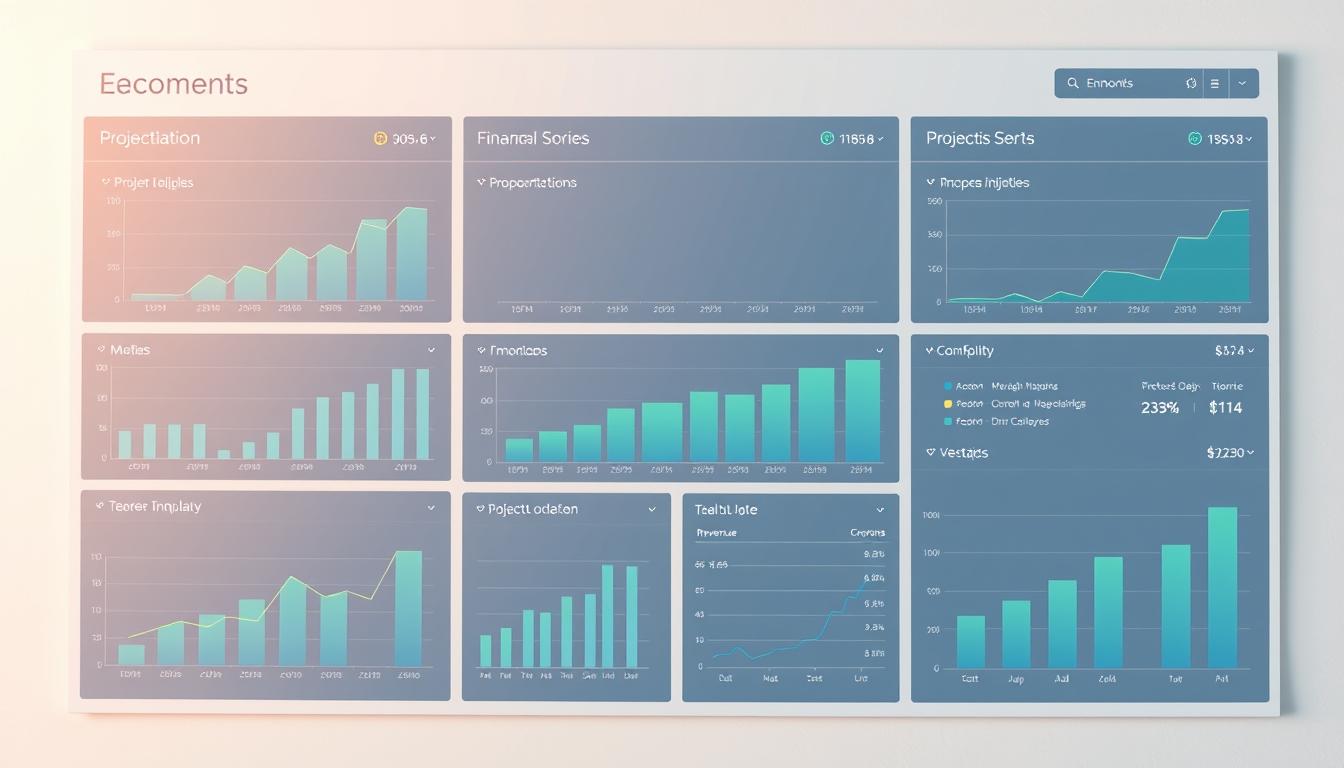As of April 2024, ByteDance, the owner of TikTok, was valued at $220 billion, making it the world’s most valuable startup. However, not all startups achieve such success; 9 out of 10 fail. According to Failory, one of the top reasons for this failure is poor financial projections.
Creating accurate financial projections is crucial for your business success. It serves as a roadmap, guiding your decisions and helping secure funding from investors. By understanding how to forecast your revenue and expenses, you can better manage your cash flow and make informed decisions.
Key Takeaways
- Accurate financial projections are critical for startup success.
- Poor financial projections are among the top reasons startups fail.
- Financial projections serve as a roadmap for business decisions.
- Understanding revenue and expenses is crucial for managing cash flow.
- Effective financial forecasting helps secure funding from investors.
Understanding Financial Projections for Startups
To navigate the challenges of launching and growing a startup, it’s essential to grasp the concept of financial projections. Financial projections are a critical component of your business strategy, providing a clear direction for your company’s future.

What Are Financial Projections?
A financial projection is a prospective financial statement that presents the expected financial position, results of operations, and cash flows of your business. It is based on assumptions about the most likely courses of action you expect your business to take, within the economic conditions which are most likely to exist over the given period.
Financial projections are educated estimates of your startup’s future financial performance, typically presented as a set of forward-looking financial statements. These projections include detailed forecasts of revenue, expenses, cash flow, and other financial metrics over a specific timeframe, usually 1-5 years.
- Financial projections serve as a numerical representation of your business strategy, translating your vision and plans into quantifiable financial outcomes.
- Unlike historical financial statements that report what has already happened, projections focus on what you expect to happen based on reasonable assumptions and market analysis.
- For startups specifically, projections are crucial as they demonstrate your understanding of your business model and market potential to investors and stakeholders.
| Key Components | Description |
|---|---|
| Revenue Forecast | Estimated revenue based on market analysis and sales projections. |
| Expense Budget | Projected expenses, including operational costs and capital expenditures. |
| Cash Flow Statement | Expected inflows and outflows of cash over the projection period. |
As noted by financial experts, “Financial projections are not just about predicting the future; they’re about creating a roadmap for success.”
“Financial projections serve as a critical tool for startups, enabling them to anticipate and prepare for future financial scenarios.”
Understanding Financial Projections for Startups
Financial projections are a cornerstone of startup success, enabling entrepreneurs to make informed decisions, secure funding, and navigate the complexities of their business environment. By creating accurate financial projections, you can better understand your startup’s financial health and make strategic decisions to drive growth.
Why Financial Projections Matter for Startups
Financial projections are essential for startups as they provide a framework for strategic planning and help founders make informed decisions about resource allocation. They serve as a roadmap for your business, outlining projected income, expenses, and cash flow. This information is critical for managing your startup’s financial resources and ensuring that you have sufficient cash to meet your obligations.
- Strategic Planning: Financial projections help you plan for the future, making informed decisions about where to allocate resources to drive growth and profitability.
- Securing Funding: Investors rely heavily on financial projections to evaluate the potential return on their investment. Accurate projections are crucial for securing the funding you need to grow your business.
- Cash Flow Management: Well-crafted projections help you identify potential cash flow issues before they become critical, allowing you to take preventive measures to manage your cash runway.
- Performance Benchmarking: Projections serve as benchmarks against which you can measure your actual performance, helping you identify areas where your business is exceeding expectations or falling short.
- Growth and Profitability: For early-stage startups, financial projections demonstrate that you understand your business model and have a realistic plan for growth and profitability.
To illustrate the importance of financial projections, consider the following table, which outlines a simplified financial projection for a startup:
| Year | Revenue | Expenses | Cash Flow |
|---|---|---|---|
| 1 | $100,000 | $80,000 | $20,000 |
| 2 | $150,000 | $120,000 | $30,000 |
| 3 | $200,000 | $160,000 | $40,000 |

By regularly reviewing and updating your financial projections, you can ensure that your startup remains on track to meet its financial goals. This proactive approach to financial planning enables you to make informed decisions, manage cash flow effectively, and drive long-term success.
Understanding Financial Projections for Startups
Understanding the difference between financial forecasts and projections is crucial for startup success. While both are essential tools for financial planning, they serve distinct purposes and are used in different contexts.
Financial Forecasts vs. Projections: Key Differences
Financial forecasts and projections are often used interchangeably, but they have distinct differences that startup founders should understand. A financial forecast is a prospective financial statement that presents the expected financial position, results of operations, and cash flows of your business, based on the most likely courses of action you expect your business to take.
Key characteristics of financial forecasts include:
- Based on historical data and current trends
- Represent the most likely financial outcomes
- Used for operational planning
- Typically short-term focused (1-2 years)
In contrast, financial projections include one or more hypothetical assumptions that might be less likely to happen. Projections are used for strategic planning and often extend further into the future (3-5+ years).
The main differences between forecasts and projections can be summarized in the following table:
| Characteristics | Financial Forecasts | Financial Projections |
|---|---|---|
| Timeframe | Short-term (1-2 years) | Long-term (3-5+ years) |
| Purpose | Operational planning | Strategic planning |
| Assumptions | Based on likely scenarios | Includes hypothetical scenarios |
As noted by financial experts, “Financial projections are essential for startups as they help in planning and decision-making.”
“Projections allow startups to anticipate and prepare for various future scenarios, making them more resilient to changes in the market.”

Understanding these differences helps you choose the right approach based on your specific needs, whether you’re planning operations, seeking investment, or evaluating strategic initiatives. By distinguishing between financial forecasts and projections, you can better navigate the complexities of financial planning for your startup.
The Critical Role of Financial Projections in Startup Success
Effective financial projections are the backbone of any successful startup, enabling you to make informed decisions about your business strategy. By creating detailed financial projections, you can align your business activities with your long-term vision and goals.
Strategic Planning and Decision Making
Financial projections serve as the foundation for strategic planning, helping you quantify the financial implications of different strategic options. This enables you to make data-driven decisions rather than relying on intuition alone.
- Financial projections help you identify the resources needed to achieve your strategic objectives, including staffing, equipment, and marketing investments.
- They allow you to test the financial viability of different business models or revenue streams before committing significant resources.
- For startups, financial projections help determine the optimal timing for key strategic moves, such as entering new markets or launching new products.
To illustrate the importance of financial projections in strategic planning, consider the following example:
| Strategic Objective | Financial Projection | Resource Allocation |
|---|---|---|
| Enter new market | $100,000 revenue in 6 months | $20,000 marketing budget |
| Launch new product | $50,000 revenue in 3 months | $15,000 product development budget |
By using financial projections to inform your strategic planning, you can make more informed decisions and drive growth in your business.

In conclusion, managing financial projections is crucial for business success, enabling you to make informed decisions and drive growth through effective planning and strategy.
The Critical Role of Financial Projections in Startup Success
When it comes to securing funding for your startup, a well-crafted financial projection is not just a document, it’s a key to unlocking investor confidence. A comprehensive financial forecast can help you articulate your business potential to investors and stakeholders, making it crucial when pitching to investors or applying for loans.
Attracting Investors with Solid Projections
Comprehensive financial projections play a pivotal role in attracting investors. Here are some key points to consider:
- Deciding Factor: Comprehensive financial projections are often the deciding factor for investors considering whether to fund your startup.
- Evaluating Potential: Investors use your projections to evaluate the potential return on their investment and assess whether your business model is scalable and sustainable.
- Demonstrating Financial Literacy: Well-prepared projections demonstrate your financial literacy and business acumen, increasing investor confidence in your ability to execute your business plan.
- Growth Trajectory: Your projections should tell a compelling story about your business’s growth trajectory, highlighting key milestones and the path to profitability.
- Defending Your Numbers: Being able to clearly explain the assumptions behind your projections and defend your numbers when questioned is crucial for building credibility with potential investors.
By creating a detailed and realistic financial projection, you can effectively communicate your startup’s potential for growth and revenue, making it more attractive to investors.

Investors are looking for startups with a clear vision and a well-planned financial strategy. By presenting a solid financial projection, you can demonstrate that your startup is a worthwhile investment opportunity.
The Critical Role of Financial Projections in Startup Success
By creating detailed financial projections, you can proactively manage risks and capitalize on growth opportunities. Financial projections serve as a roadmap for your startup, helping you navigate through complex market conditions and make informed decisions.
Risk Assessment and Mitigation
Financial projections are instrumental in identifying potential financial risks and developing strategies to mitigate them. This proactive approach enhances your risk management capabilities, ensuring that your startup is better equipped to handle unforeseen challenges.
- Identifying Potential Risks: Financial projections help you identify potential risks to your business by highlighting periods of negative cash flow or unsustainable expenses.
- Scenario Planning: By creating multiple scenario projections (best-case, worst-case, and most likely), you can prepare contingency plans for various market conditions, ensuring that your startup is prepared for different outcomes.
- Opportunity Identification: Projections can reveal opportunities for growth or cost savings that might not be obvious without a detailed financial analysis, enabling you to make the most of your business’s potential.
- Key Drivers: They help you identify the key drivers of your business’s financial performance, allowing you to focus your efforts on the factors that will have the greatest impact.
- Regular Review: Regular review of your projections against actual results helps you spot emerging trends or issues early, giving you time to adjust your strategy accordingly.
Effective financial projections enable startups to navigate complex market conditions and make informed decisions. By modeling different scenarios, financial projections assist in identifying potential financial risks and developing strategies to mitigate them. This proactive approach enhances risk management and ensures that your startup is well-prepared to handle the challenges of the market.
In conclusion, financial projections are a critical tool for startups, enabling them to identify potential risks and opportunities, make informed decisions, and drive growth. By incorporating detailed financial analysis and scenario planning into your business strategy, you can ensure that your startup is well-equipped to succeed in a competitive market.
Essential Components of Startup Financial Projections
Your sales forecast serves as the foundation for your startup’s financial planning. It predicts your primary source of revenue and drives many other financial calculations. A comprehensive sales forecast breaks down revenue by product or service line, showing unit sales, pricing, and total revenue for each offering.
Building a Comprehensive Sales Forecast
To create an effective sales forecast, you need to base it on thorough market research, including market size, target customer segments, and competitive analysis. This research will help you understand your potential sales and growth opportunities.
As emphasized by financial experts, “A good sales forecast is not just about predicting sales; it’s about understanding the factors that drive those sales and being able to adjust your strategy accordingly.”
This involves considering seasonal variations, industry trends, and the impact of your planned marketing and sales activities on your projections.
- Document the assumptions behind your sales forecast, such as customer acquisition rates, conversion rates, and average transaction values, to make your projections credible and defensible.
- Break down your sales forecast into different sections for each line of sale, showing the number of unit sales, pricing, cost of sales, and gross margin based on past and current sales data.
- Regularly review and update your sales forecast to reflect changes in the market or your business operations, ensuring your financial projections remain accurate and relevant.
By following these guidelines, you can create a robust sales forecast that supports your startup’s financial planning and helps drive growth. A well-crafted sales forecast is essential for making informed financial decisions and achieving your business objectives.
Essential Components of Startup Financial Projections
A detailed expense budget helps you anticipate and manage the expenses required to achieve your business goals. Your expense budget is a critical component of your financial projections, as it outlines the costs associated with running your startup and achieving your projected sales.
Managing Expenses Effectively
To create an effective expense budget, you need to distinguish between fixed costs and variable costs. Fixed costs remain constant regardless of your sales volume, while variable costs fluctuate with your sales volume.
Fixed costs typically include expenses like:
- Payroll
- Office rent
- Phone and internet costs
- Insurance
Variable costs, on the other hand, include expenses like:
- Advertising and promotional activities
- Cost of raw materials
- Credit card fees
- Seasonal workers
It’s also important to include one-time startup costs in your expense budget, such as equipment purchases, legal fees for incorporation, and initial marketing expenses. As your business grows, your expense budget should account for future hiring needs, including salaries, benefits, taxes, and other employee-related expenses.
By understanding your fixed and variable costs, you can make informed decisions about your business operations and manage your expenses effectively. This will help you stay on track with your financial projections and achieve your business goals.
Essential Components of Startup Financial Projections
Managing your startup’s financial health is crucial, and a key component of this is understanding your cash flow statement. As you navigate the complexities of financial planning, leveraging the right tools can make a significant difference.

Cash Flow Statement
A cash flow statement is a document that shows how much money is coming in and going out of your startup. It helps you know when you might have too much or too little money. Your cash flow statement shows the actual amounts of money you expect will be moving in and out of your business during the period you are forecasting.
It’s essential to work on the assumption that only 80 percent or less of your invoices will be paid within 30 days. This conservative approach helps you prepare for potential delays in payment.
The cash flow statement is often considered the most critical financial projection for startups, as it shows when cash will enter and leave your business. Unlike the income statement, which recognizes revenue when earned and expenses when incurred, the cash flow statement tracks actual cash movements, accounting for timing differences between billing and payment.
For startups, the cash flow statement helps identify potential cash shortfalls before they occur, allowing you to take preventive measures such as accelerating collections, delaying payments, or securing additional funding. Your cash flow projection should account for payment terms with customers and suppliers, recognizing that you may not receive payment for sales immediately and that you may have to pay for expenses before generating revenue.
A detailed statement typically includes operating activities (day-to-day business), investing activities (purchasing assets), and financing activities (raising capital or paying dividends). By closely monitoring your cash flow, you can make informed decisions about your business projections and adjust your strategies accordingly.
- The cash flow statement is often considered the most critical financial projection for startups.
- Unlike the income statement, it tracks actual cash movements.
- For startups, it helps identify potential cash shortfalls before they occur.
- Your cash flow projection should account for payment terms with customers and suppliers.
- A detailed statement includes operating, investing, and financing activities.
Essential Components of Startup Financial Projections
Financial projections are a crucial aspect of startup planning, but many new businesses make avoidable errors. One of the key components of financial projections is the income projection statement.
Income Projection Statement
The income projection statement, also known as the profit and loss statement, is a critical tool for startups. It estimates your revenues, costs, and profitability over a specific period. This statement provides a clear picture of your business’s profitability, showing whether your revenue will exceed your expenses and by how much.
To create an effective income projection statement, you should break down revenue by source and expenses by category. This allows you to analyze the profitability of different aspects of your business. For instance, you can identify areas where you can increase revenue or decrease production costs.
Here are some key metrics derived from the income statement:
- Gross profit margin (revenue minus cost of goods sold)
- Operating margin (profit from operations before interest and taxes)
- Net profit margin (profit after all expenses)
| Metric | Description | Importance |
|---|---|---|
| Gross Profit Margin | Revenue minus cost of goods sold | Indicates production efficiency |
| Operating Margin | Profit from operations before interest and taxes | Shows operational profitability |
| Net Profit Margin | Profit after all expenses | Reflects overall business profitability |
By understanding and utilizing these metrics, you can create a comprehensive income projection statement that guides your startup towards profitability.
How to Manage Financial Projections for Your Startup
Clear financial goals are the foundation upon which successful startup financial projections are built. Before diving into the numbers, it’s essential to understand the purpose of your financial model, which will help you decide how detailed it should be.
Aligning Financial Goals with Business Objectives
Your financial goals should align with your overall business objectives and reflect your vision for the company’s growth and development. Specific financial objectives might include reaching a certain revenue milestone, achieving a target profit margin, securing a specific amount of funding, or maintaining a minimum cash reserve.
For instance, a startup might set a goal to increase revenue by 20% within the next 12 months or to achieve a certain level of profitability within the first three years. These goals provide a framework for your financial projections and help you evaluate different scenarios and strategies.
Key Considerations for Setting Financial Goals:
- Align financial goals with overall business objectives
- Consider both short-term and long-term aspirations
- Set specific, measurable targets
- Regularly review and adjust financial goals as necessary
When setting financial goals, consider both short-term objectives (next 12 months) and long-term aspirations (3-5 years), creating a roadmap for your startup’s financial journey. This approach enables you to develop a comprehensive financial projection that guides your business decisions.
| Financial Goal | Short-Term (Next 12 months) | Long-Term (3-5 years) |
|---|---|---|
| Revenue Growth | 15% increase | 50% increase |
| Profit Margin | 10% target | 20% target |
| Funding | Secure $500,000 | Secure $2,000,000 |
As
“The way to get started is to quit talking and begin doing.”
This quote emphasizes the importance of taking action towards your financial goals.
By setting clear financial goals and objectives, you can create a robust financial projection that guides your startup’s growth and development. Regularly reviewing and adjusting your financial goals will help you stay on track and achieve success.
How to Manage Financial Projections for Your Startup
When managing financial projections for your startup, determining the right timeframe is crucial. This decision significantly impacts the accuracy and relevance of your projections, which in turn affect your business decisions and ability to attract investors.
Timeframe Considerations for Financial Projections
Most businesses use two types of financial projections: short-term and mid-term. Short-term projections typically cover the first year of business, broken down month by month, while mid-term projections usually span three years, with yearly breakdowns. Both are essential for startups and small to medium-sized businesses seeking investment.
- Choosing the appropriate timeframe for your financial projections is crucial for their relevance and accuracy.
- Most startup financial projections include both short-term (12-18 months) and medium-term (3-5 years) forecasts, each serving different purposes.
- Short-term projections should be detailed (typically month-by-month) and focus on operational planning, cash flow management, and immediate business needs.
- Medium-term projections are usually less granular (quarterly or annual) and focus on strategic planning, growth trajectories, and potential funding requirements.
- The appropriate timeframe for your projections may vary depending on your industry, business model, and stage of development, with longer timeframes generally being less reliable due to increasing uncertainty.
To determine the most suitable timeframe for your startup’s financial projections, consider your business needs and goals. For instance, if you’re seeking funding, you’ll want to provide investors with a clear picture of your financial situation over the next few years. This might involve creating detailed short-term projections and more strategic mid-term projections.
By carefully selecting the timeframe for your financial projections and ensuring they are based on realistic data and forecasting, you can create a robust financial plan that supports your startup‘s growth and success.
How to Manage Financial Projections for Your Startup
Effective financial planning for your startup requires selecting the right approach for your financial projections, either top-down or bottom-up. This decision is crucial as it directly impacts the accuracy and reliability of your projections.
Top-Down vs. Bottom-Up Approaches
When creating financial projections, you can choose between two primary methodologies: top-down and bottom-up approaches. Each has distinct advantages and limitations. The top-down approach starts with the total addressable market (TAM) and estimates what percentage of that market your startup can capture, then derives revenue and other financial metrics from that market share.
In contrast, the bottom-up approach builds projections from granular operational details, such as the number of sales representatives, their productivity, conversion rates, and average deal sizes. This results in more detailed and often more defensible projections.
Most effective financial projections combine elements of both approaches, using market analysis to validate bottom-up projections and ensure they’re realistic within the context of your industry. Your choice between these approaches may depend on your startup’s stage, the availability of data, and the specific purpose of your projections. Early-stage startups often rely more on top-down methods due to limited operational history.
As emphasized by financial experts, “A combination of both top-down and bottom-up approaches provides a comprehensive view of your startup’s financial future.” This integrated approach allows for more robust financial planning and better decision-making.
- The top-down approach is useful for estimating market potential and setting overall business goals.
- The bottom-up approach is beneficial for detailed operational planning and resource allocation.
- Combining both approaches can provide a balanced view, leveraging the strengths of each methodology.
By understanding the strengths and limitations of each approach, you can make informed decisions about your financial projections, ultimately driving your startup’s success.
Step-by-Step Guide to Creating Your First Financial Projection
Accurate financial projections are the backbone of any successful startup, and it all begins with a solid understanding of your business data. To create reliable financial projections, you need to gather and analyze your startup’s historical financial statements, including balance sheets, income statements, cash flow statements, and operational metrics such as sales, marketing, and product data.
Gathering Historical Data and Market Research
The foundation of accurate financial projections is solid data, including both historical performance metrics for your business and comprehensive market research. For established startups, gather and analyze past financial statements, sales records, expense reports, and operational metrics to identify trends and patterns that can inform your projections.
If you’re a new startup without historical data, focus on industry benchmarks, competitor analysis, and market research to establish realistic baseline assumptions for your projections. Market research should include analysis of your total addressable market (TAM), customer segments, pricing trends, competitive landscape, and industry growth rates.
- Gather and analyze past financial statements, sales records, expense reports, and operational metrics to identify trends and patterns.
- Use industry benchmarks, competitor analysis, and market research if you don’t have historical data.
- Pay special attention to seasonality, sales cycles, and other patterns that might affect your business’s financial performance throughout the year.
By following these steps, you can create a robust foundation for your financial projections, ensuring they are grounded in reality and better equipped to guide your startup towards success.
Step-by-Step Guide to Creating Your First Financial Projection
Organizing your financial information by category is a critical step in developing a comprehensive financial projection. This process enables you to understand your business’s financial health and make informed decisions.
Categorizing Revenue and Expenses
To create structured and accurate financial projections, you need to categorize your revenue streams and expenses. Start by categorizing your revenue streams by product line, service type, customer segment, or geographic region to understand the different drivers of your business’s income.
Categorizing Revenue Streams
- Product line
- Service type
- Customer segment
- Geographic region
Similarly, categorize your expenses into fixed costs (rent, salaries, insurance) and variable costs (materials, commissions, shipping) to better understand your cost structure.
Expense Categories
| Expense Type | Description | Examples |
|---|---|---|
| Fixed Costs | Expenses that remain the same even if the business produces more or less | Rent, Salaries, Insurance |
| Variable Costs | Expenses that change in proportion to the amount of goods or services produced | Materials, Commissions, Shipping |
| One-time Expenses | Expenses that occur only once | Equipment Purchase, Legal Fees |
Utilizing accounting software or financial planning tools can significantly streamline this organization process and ensure consistency in your categorization approach.
By organizing your financial information into clear, logical categories, you can create a robust financial projection that guides your business decisions.
Step-by-Step Guide to Creating Your First Financial Projection
Now that you have gathered and organized your data, it’s time to calculate your projected revenue and expenses. This step is crucial in creating a comprehensive financial projection that will help you make informed decisions about your business.
Calculating Projected Revenue
To calculate your projected revenue, you need to consider several factors, including your pricing strategy, sales volume, customer acquisition rates, retention rates, and upselling opportunities. By analyzing these factors, you can build a comprehensive forecast that accurately predicts your revenue.
- Pricing strategy: Determine how much you will charge for your products or services.
- Sales volume: Estimate the number of units you will sell.
- Customer acquisition rates: Calculate how many new customers you will acquire.
- Retention rates: Determine how many customers you will retain.
- Upselling opportunities: Identify opportunities to sell additional products or services to existing customers.
Calculating Projected Expenses
When projecting expenses, you need to account for both fixed costs that remain constant regardless of business activity and variable costs that fluctuate with sales volume or other operational factors. Don’t forget to include often-overlooked expenses such as taxes, insurance, maintenance, software subscriptions, professional services, and contingency funds for unexpected costs.
- Fixed costs: Rent, salaries, and equipment expenses.
- Variable costs: Raw materials, marketing expenses, and distribution costs.
- Other expenses: Taxes, insurance, and contingency funds.
To create a realistic financial projection, it’s essential to consider multiple scenarios, including conservative, moderate, and optimistic projections. This will help you understand the range of possible outcomes and prepare for different financial situations.
By following these steps, you can create a comprehensive financial projection that will help you make informed decisions about your business and achieve your financial goals.
Developing Accurate Sales Forecasts
Understanding your Total Addressable Market (TAM) is a critical step in developing a sales forecast that accurately reflects your business potential. TAM represents the total revenue opportunity available if you could capture 100% of the market, providing an upper boundary for your growth potential.
Analyzing Your Total Addressable Market
Analyzing your TAM involves identifying the total number of potential customers in your target market and multiplying it by the average revenue per customer. This calculation gives you a comprehensive view of the market’s potential scale and scope, helping you position your startup competitively.
Key Steps in TAM Analysis:
- Identify the total number of potential customers in your target market.
- Determine the average revenue per customer.
- Calculate your TAM by multiplying the number of potential customers by the average revenue per customer.
- Beyond TAM, calculate your Serviceable Available Market (SAM) and Serviceable Obtainable Market (SOM) for more realistic projections.
- Base your market share assumptions on competitive analysis, your unique value proposition, and your go-to-market strategy.
By understanding your TAM, SAM, and SOM, you can set realistic financial and operational milestones, laying down a blueprint for sustainable growth and business success. Most startups realistically capture only a small percentage of their TAM, so it’s essential to have a clear understanding of your market share assumptions.
Accurate sales forecasts rely heavily on thorough market analysis and revenue projections. By analyzing your TAM and understanding your market’s potential, you can create more accurate sales projections and business projections that guide your startup’s strategic decisions.
Developing Accurate Sales Forecasts
A sales pipeline forecast is a powerful tool that helps you predict future revenue by analyzing potential sales opportunities and their likelihood of closing. It weighs all the factors that play a part in each potential deal, enabling you to make informed decisions and drive business growth.
Pipeline Forecast Essentials
To create an effective pipeline forecast, you need to define the stages of your sales process, from initial contact to closed deal, and assign probability percentages to each stage. This will help you understand the progression of potential customers through your sales process and identify areas for improvement.
Here are the key steps to create a reliable pipeline forecast:
- Define your sales process stages: Identify the different stages that a potential customer goes through, from initial contact to closed deal.
- Assign probability percentages: Assign a probability percentage to each stage, based on the likelihood of closing a deal.
- Track prospects: Track the number of prospects at each stage of your pipeline and multiply by the average deal size and probability of closing to calculate expected revenue.
- Use industry benchmarks: For startups with limited historical data, use industry benchmarks for conversion rates between pipeline stages while you gather your own data.
- Regularly update your forecast: Regularly update your pipeline forecast as new opportunities enter the pipeline and existing opportunities progress or drop out.
By following these steps, you can create a pipeline forecast that helps you prioritize sales efforts, adjust marketing strategies, and set realistic revenue targets. This will enable you to make informed decisions and drive business growth.
Developing Accurate Sales Forecasts
The accuracy of your sales forecast depends on your ability to analyze and incorporate seasonality and market trends into your projections. A well-crafted sales forecast is essential for making informed business decisions and driving growth.
Accounting for Seasonality and Market Trends
To create a realistic sales forecast, you need to understand the factors that influence your sales throughout the year. This includes analyzing historical sales data to identify seasonal patterns, such as holiday spikes or summer slumps, that may affect your business.
- Analyze historical sales data to identify seasonal patterns and trends.
- Consider broader market trends that could impact your sales, including technological advancements, changing consumer preferences, economic conditions, and regulatory changes.
- For B2B startups, account for the typical buying cycles of your target customers, including budget approval processes and fiscal year considerations.
Beyond seasonality, it’s crucial to consider broader market trends that could impact your sales. This includes staying up-to-date with the latest developments in your industry and understanding how they might affect your business.
Building flexibility into your sales projections is also vital. This allows you to adjust your forecasts as new trends emerge or existing patterns change, ensuring that your business remains adaptable and responsive to shifting market conditions.
By taking a comprehensive approach to sales forecasting, you can create a more accurate and reliable forecast that reflects the complexities of your business and the market in which you operate.
Managing Expense Projections Effectively
Effective management of expense projections is crucial for the financial health of your startup. To achieve this, it’s essential to understand the different types of costs associated with your business operations.
Distinguishing Between Fixed and Variable Costs
Your startup’s expenses can be broadly categorized into fixed and variable costs. Fixed costs remain relatively constant regardless of your business activity level. Examples include:
- Payroll
- Office rent
- Phone and internet costs
- Insurance
On the other hand, variable costs fluctuate in direct proportion to your business activity. These include:
- Advertising and promotional activities
- Cost of raw materials
- Credit card fees
- Seasonal workers
Understanding the distinction between these costs is fundamental to creating accurate expense projections. By recognizing which costs are fixed versus variable, you can better calculate your break-even point, understand your cost structure, and make informed decisions about pricing and scaling your operations.
| Cost Type | Description | Examples |
|---|---|---|
| Fixed Costs | Remain constant regardless of business activity | Payroll, Office rent, Insurance |
| Variable Costs | Fluctuate with business activity | Raw materials, Advertising, Credit card fees |
| Semi-Variable Costs | Have both fixed and variable components | Utilities (base charge + usage fees) |
It’s also important to identify semi-variable costs, which have both fixed and variable components. Utilities with base charges plus usage fees are a common example. Properly categorizing these costs in your projections will enhance their accuracy.
Managing Expense Projections Effectively
To manage your startup’s finances effectively, you need to project operating expenses accurately. This involves understanding the various costs associated with running your business and forecasting them over a specific period.
Projecting Operating Expenses
Projecting operating expenses accurately is crucial for understanding your startup’s cash needs and path to profitability. To achieve this, you should start by categorizing your operating expenses into major categories.
- Personnel expenses should include not just salaries but also payroll taxes, benefits, bonuses, and the timing of planned hires as your startup grows.
- Facilities costs should cover rent, utilities, maintenance, security, and any planned expansions or relocations as your team grows.
- Technology expenses should include hardware, software subscriptions, hosting services, and IT support, with consideration for how these costs will scale with your business.
By regularly reviewing and updating your expense forecasts, you can make informed decisions about cost-cutting measures, investments, and budget adjustments, reducing the risk of overspending.
Effective expense projection also involves understanding the difference between fixed and variable costs. Fixed costs remain the same even if your business produces more or less of its product or service, while variable costs change in proportion to the level of production or sales.
Managing Expense Projections Effectively
To maintain financial stability, startups need to manage their expense projections carefully. This involves not just forecasting regular expenses but also planning for unexpected costs that can arise at any time.
Planning for Unexpected Costs
Even the most detailed expense projections can’t anticipate every cost your startup will face, making it essential to plan for unexpected expenses. A key strategy is to include a contingency fund in your financial projections, typically 10-20% of your total projected expenses, to cover unforeseen costs without derailing your financial plan.
Identifying potential risk areas specific to your business and industry is crucial. These could include regulatory changes, supply chain disruptions, or technology failures that might lead to unexpected expenses. For instance, a startup in the tech industry might need to plan for potential data security breaches or software failures.
Consider creating separate emergency funds for different categories of potential unexpected costs, such as legal issues, equipment failures, or market downturns. This approach allows you to be more prepared for various scenarios. Regularly reviewing and updating your contingency plans as your business evolves and new potential risks emerge is also vital, ensuring you’re always prepared for the unexpected.
For more detailed guidance on making financial projections, you can refer to resources like BDC’s 6 steps to making financial projections for a new. This can help you develop a comprehensive financial plan that includes provisions for unexpected costs.
- Including a contingency fund in your financial projections to cover unforeseen costs.
- Identifying potential risk areas specific to your business and industry.
- Creating separate emergency funds for different categories of potential unexpected costs.
- Regularly reviewing and updating your contingency plans as your business evolves.
By incorporating these strategies into your financial planning, you can better manage your startup’s expenses and be more resilient in the face of unexpected costs.
Cash Flow Projections: The Lifeblood of Your Startup
Understanding the difference between cash flow and profitability is vital for startup founders. While profitability indicates the financial health of your business on paper, cash flow reflects the actual money available to meet financial obligations.
Understanding Cash Flow vs. Profitability
Cash flow refers to the movement of money into or out of your business, whereas profitability is the accounting representation of your business’s revenue minus expenses. A profitable business can still face cash flow problems if customers delay payments while the business must pay its suppliers promptly.
Conversely, a business might show negative profitability on paper but have a positive cash flow if it receives advance payments from customers or negotiates favorable payment terms with suppliers. For startups, managing cash flow is often more critical than showing accounting profits because running out of cash can lead to business failure, regardless of profitability.
Key Considerations:
- Cash flow management is crucial for meeting financial obligations and investing in growth opportunities.
- Profitability is essential for long-term sustainability, but it doesn’t guarantee cash availability.
- Startups must balance both aspects to ensure financial stability and growth.
By understanding and managing both cash flow and profitability, you can make informed decisions about your business’s financial strategy, ensuring it remains viable and poised for growth.
Cash Flow Projections: The Lifeblood of Your Startup
Your startup’s financial health relies heavily on its ability to manage cash flow effectively. Cash flow is the movement of money into or out of your business, and maintaining a positive cash flow is crucial for meeting financial obligations and driving growth.
Efficient Strategies for Cash Flow Management
To maintain healthy cash flow, you need to implement effective management strategies. Here are some key approaches to consider:
- Accelerate cash inflows by offering early payment discounts and implementing efficient invoicing processes.
- Manage cash outflows by negotiating favorable payment terms with suppliers and timing major purchases strategically.
- Maintain a cash reserve sufficient to cover at least 3-6 months of operating expenses.
- Implement regular cash flow forecasting and monitoring processes to identify potential issues before they become critical.
Effective cash flow management involves a combination of these strategies, tailored to your startup’s specific needs and circumstances.
| Cash Flow Strategy | Description | Benefits |
|---|---|---|
| Early Payment Discounts | Offering discounts to customers who pay early | Accelerates cash inflows, improves cash flow |
| Efficient Invoicing | Implementing a streamlined invoicing process | Reduces delays in payment, improves cash flow |
| Negotiating with Suppliers | Negotiating favorable payment terms with suppliers | Delays cash outflows, improves cash flow |
By implementing these strategies and maintaining a close eye on your projections, you can ensure that your startup remains financially healthy and operationally stable.
Cash Flow Projections: The Lifeblood of Your Startup
Cash flow projections are essential for identifying potential financial gaps in your startup. By analyzing your cash inflows and outflows, you can anticipate and prepare for periods of financial strain.
Identifying and Addressing Cash Flow Gaps
Identifying potential cash flow gaps in advance is crucial for proactive financial management and avoiding crisis situations in your startup. Your cash flow projections help you pinpoint periods when expected cash outflows exceed inflows, creating a visual representation of potential gaps that require attention.
When you identify a potential cash flow gap, develop a specific action plan that might include:
- Accelerating receivables to improve cash inflows
- Delaying non-essential expenditures to reduce cash outflows
- Securing short-term financing to bridge the gap
For seasonal businesses or those with irregular revenue patterns, plan ahead by building cash reserves during high-income periods to cover anticipated gaps during slower periods. Consider alternative financing options for addressing cash flow gaps, such as invoice factoring, inventory financing, or revenue-based financing, which may be more accessible for startups than traditional loans.
Effective cash flow management involves regularly reviewing and updating your cash flow projections to ensure they remain accurate and relevant. By doing so, you can make informed decisions about your business and take proactive steps to maintain a healthy cash flow.
Financial Projection Tools and Software
For startups, financial projections are a critical component of business planning, and spreadsheet-based solutions are often the go-to choice. As you navigate the complex world of financial management, having the right tools at your disposal can make all the difference in creating accurate and reliable projections.
Spreadsheet-Based Solutions
Spreadsheet-based solutions like Microsoft Excel and Google Sheets remain popular tools for creating financial projections due to their flexibility, accessibility, and low cost. These tools allow you to create custom financial models tailored to your specific business needs, with the ability to link formulas across worksheets for integrated projections.
Key Benefits of Spreadsheet-Based Solutions
- Flexibility in creating custom financial models
- Ability to link formulas across worksheets for integrated projections
- Low cost, with many organizations offering free or low-cost templates
- Suitable for early-stage startups with straightforward business models
Many organizations offer free or low-cost financial projection templates for startups, providing a structured starting point that you can customize rather than building from scratch. However, it’s essential to be aware of the potential limitations of spreadsheet-based solutions, including the risk of formula errors, challenges with version control, and limited collaboration features compared to specialized financial planning software.
| Feature | Microsoft Excel | Google Sheets |
|---|---|---|
| Cost | Paid license | Free, with premium features |
| Collaboration | Limited real-time collaboration | Real-time collaboration |
| Formula Complexity | Advanced formula capabilities | Simplified formula capabilities |
By understanding the strengths and limitations of spreadsheet-based solutions, you can make informed decisions about the best tools for your startup’s financial projection needs.
Financial Projection Tools and Software
As startups navigate the complex world of financial management, cloud-based financial planning platforms have emerged as a game-changer. These platforms offer a robust solution for creating and managing sophisticated financial projections.
Streamlining Financial Projections
Cloud-based financial planning platforms provide significant advantages over traditional spreadsheets for startups. They integrate directly with your accounting software, CRM, and other business systems, automatically importing actual financial data to keep your projections current.
Key Benefits of Cloud-Based Platforms
- Industry-specific templates and benchmarks help create realistic projections based on data from similar businesses in your sector.
- Collaboration features allow multiple team members to work on financial projections simultaneously, with version control and audit trails to track changes.
- Advanced visualization tools present financial projections in an intuitive, graphical format, making it easier to identify trends, opportunities, and potential issues.
By leveraging these cloud-based platforms, startups can automate and organize their financial forecasting. This integration of real-time financial data, combined with AI projections, eliminates the need for manual spreadsheet updates. As a result, forecasts update instantly as new data comes in, ensuring accuracy and saving founders from tedious number-crunching.
With the ability to generate multiple scenarios based on actual performance, startups can make informed decisions about their financial future. This level of sophistication in financial projections is crucial for attracting investors and securing funding.
In conclusion, cloud-based financial planning platforms are revolutionizing the way startups manage their financial projections. By providing real-time data integration, collaboration tools, and advanced visualization, these platforms empower startups to make data-driven decisions and drive their business forward.
Financial Projection Tools and Software
As startups navigate the complex landscape of financial planning, AI-powered forecasting tools are emerging as a game-changer. These advanced tools are transforming the way businesses approach financial projections, offering capabilities that go beyond traditional spreadsheets and cloud-based platforms.
Revolutionizing Financial Projections with AI
AI-powered forecasting tools use machine learning algorithms to analyze historical data, identify patterns, and generate more accurate projections than would be possible with manual methods alone. This enables startups to make more informed decisions about their business strategy.
One of the key benefits of AI forecasting solutions is their ability to automatically create multiple scenario projections based on different sets of assumptions. This helps you understand the range of possible outcomes for your startup, allowing for more effective planning and risk management.
- AI-powered forecasting tools can incorporate external data sources such as market trends, economic indicators, and industry benchmarks to enhance the accuracy and context of your financial projections.
- These tools can help you identify potential risks and opportunities, enabling you to adjust your forecast accordingly.
- By leveraging AI-driven insights, you can develop a more nuanced understanding of your business and make more informed decisions.
While AI-powered tools are incredibly powerful, they still require human oversight to ensure that the assumptions and logic behind the projections align with your business strategy and market realities.
By combining the strengths of AI-powered forecasting tools with human expertise, you can create comprehensive and accurate financial projections that drive your startup‘s success.
Common Mistakes in Startup Financial Projections
Overestimating revenue growth is a common pitfall for startups when creating financial projections. Many startups are overly optimistic about how quickly they’ll acquire customers and generate revenue. This optimism, while beneficial for morale, can lead to unrealistic financial projections that may damage credibility with investors.
Understanding the Impact of Overestimation
Overestimating revenue growth typically manifests as unrealistic assumptions about customer acquisition rates, market penetration speed, or the pace at which new products can be developed and launched. For instance, a startup might assume a higher market share than is realistically achievable in the initial years. Such overly aggressive revenue projections can lead to poor strategic decisions and misallocation of resources.
To avoid this pitfall, it’s crucial to base your revenue projections on solid market research, industry benchmarks, and realistic assumptions about your sales cycle and customer acquisition process. Consider using a “bottom-up” approach to revenue forecasting, building projections based on specific customer acquisition channels, conversion rates, and average deal sizes rather than broad market share assumptions.
A practical approach to creating more accurate revenue projections involves analyzing your total addressable market and understanding the competitive landscape. This includes identifying your target customer segments and their potential purchasing power.
| Revenue Projection Component | Description | Example |
|---|---|---|
| Customer Acquisition Channels | Methods used to acquire new customers | Social media marketing, content marketing |
| Conversion Rates | Percentage of potential customers who make a purchase | 2% conversion rate on website visitors |
| Average Deal Size | Average revenue generated per customer | $1000 per sale |
By focusing on these specific elements, startups can create more realistic and achievable revenue projections. This not only enhances credibility with investors but also helps in making informed strategic decisions.
Common Mistakes in Startup Financial Projections
A critical error in financial projections is underestimating expenses, which can lead to cash flow problems and funding shortfalls for your startup. When creating financial projections, it’s essential to account for all operating costs, including both obvious and hidden expenses.
Underestimating Expenses
Many founders fail to account for “hidden” costs beyond the obvious expenses, such as regulatory compliance, insurance, taxes, maintenance, professional services, and employee benefits. To avoid this mistake, it’s crucial to thoroughly research and understand all the expenses associated with running your business.
- Underestimating expenses can lead to financial strain and impact your ability to secure funding.
- Scaling costs are often underestimated, with many expenses growing exponentially as the business expands.
- One-time costs for major initiatives are frequently overlooked or underbudgeted in long-term projections.
- To create more accurate expense projections, research industry benchmarks and consult with experienced advisors.
By understanding the common pitfalls in financial planning, you can create more robust and realistic projections for your startup. This involves not only accounting for all potential expenses but also regularly reviewing and updating your financial plans to reflect the current state of your business.
Common Mistakes in Startup Financial Projections
When creating financial projections, it’s easy to get caught up in internal goals and forget about the external market realities that can make or break your startup. A thorough understanding of the market landscape is crucial for developing realistic and achievable financial projections.
Ignoring Market Realities
Ignoring market realities is a serious mistake that can undermine the credibility and usefulness of your financial projections. Many startups create projections in isolation, without adequately considering competitive pressures, pricing constraints, market saturation, or industry-specific challenges that could impact their growth.
Failing to account for market seasonality, buying cycles, or regulatory factors can lead to projections that miss the mark in timing and magnitude of revenue and expenses. Some founders overlook macroeconomic factors like economic cycles, interest rate changes, or supply chain disruptions that could significantly affect their business performance.
To ground your projections in market realities, conduct thorough competitive analysis, stay informed about industry trends, and regularly update your assumptions based on changing market conditions. This will help you create financial projections that are both realistic and achievable, ultimately strengthening your startup’s strategic planning and decision-making.
- Conduct thorough market research to understand your total addressable market (TAM), customer segments, and pricing trends.
- Stay informed about industry trends and competitive landscape to ensure your projections are realistic.
- Regularly update your assumptions based on changing market conditions to maintain the credibility of your financial projections.
By avoiding the mistake of ignoring market realities, you can develop financial projections that accurately reflect your startup’s potential and guide you toward success.
Common Mistakes in Startup Financial Projections
One of the most significant mistakes startups make is failing to update their financial projections regularly. Financial forecasting is an ongoing process that requires startups to review and update their projections as new information emerges regularly.
Updating Projections for Better Management
Treating financial projections as a one-time exercise rather than an ongoing process diminishes their value as a management tool. Many startups create detailed projections for fundraising purposes but then fail to update them regularly as the business evolves and actual results become available.
Without regular updates, projections quickly become outdated and irrelevant, particularly in fast-moving industries or during periods of rapid growth or change. Failing to compare actual results against projections means missing valuable opportunities to learn from variances and improve your understanding of your business drivers.
To avoid this, establish a regular cadence for updating your financial projections (monthly or quarterly), incorporating actual results, reassessing assumptions, and adjusting future projections based on new information and changing conditions. This will enable you to remain financially agile and responsive to changing market conditions, ultimately improving your performance and management of the startup.
- Regularly compare actual data with your projections to identify discrepancies.
- Analyze variances to understand the drivers behind them and adjust your strategies accordingly.
- Revise your forecasts as needed to reflect new information or changing circumstances, ensuring that your financial projections remain relevant and accurate.
By doing so, you can ensure that your financial projections continue to serve as a valuable tool for guiding your business decisions and driving performance.
Creating Multiple Scenario Projections
As you develop financial projections for your startup, considering multiple scenarios will help you better understand the potential risks and opportunities that lie ahead. This approach enables you to anticipate various outcomes and make informed decisions about your business’s future.
Best-Case Scenario Planning
Best-case scenario planning involves projecting your startup’s financial performance under optimal conditions, providing a vision of what’s possible with exceptional execution and favorable market conditions. This scenario typically assumes faster customer acquisition, higher conversion rates, better pricing power, and more efficient operations than your base case projections.
While optimistic, your best-case scenario should still be grounded in reality and supported by specific assumptions about what would drive these superior results. For instance, you might assume that a new marketing strategy will increase your customer acquisition rate or that a new product feature will boost sales.
- Best-case projections can help you identify the potential upside of your business model and prepare for rapid scaling if things go better than expected.
- This scenario is particularly useful for understanding resource needs under high-growth conditions and for highlighting the potential return for investors in favorable circumstances.
To illustrate the potential outcomes, consider the following table that compares different scenarios:
| Scenario | Revenue Growth | Expense | Net Profit |
|---|---|---|---|
| Best-Case | 20% | $100,000 | $200,000 |
| Base-Case | 10% | $80,000 | $120,000 |
| Worst-Case | 5% | $120,000 | $50,000 |
As the table demonstrates, best-case scenario planning can help you understand the potential financial implications of different outcomes. By considering multiple scenarios, you can develop a more comprehensive financial plan that prepares your startup for various possibilities.
According to financial experts, considering multiple scenarios is crucial for making accurate financial projections. As one expert notes, “The best method for making accurate financial projections that are realistic is to consider multiple scenarios and plan for unexpected events.”
“The best method for making accurate financial projections that are realistic is to consider multiple scenarios and plan for unexpected events.”
Creating Multiple Scenario Projections
When creating multiple scenario projections, it’s crucial to consider the worst-case scenario to ensure your startup’s resilience. This involves modeling various adverse conditions that could impact your business.
Worst-Case Scenario Planning
Worst-case scenario planning is a critical risk management exercise that helps you prepare for challenging business conditions. This scenario should include slower customer acquisition, higher customer acquisition costs, and potential operational challenges.
Pay particular attention to cash flow in your worst-case scenario, as understanding how long your startup can survive with minimal revenue is essential for contingency planning. You should identify potential breaking points in your business model and develop specific action plans for cost-cutting or strategic pivots if necessary.
| Scenario | Customer Acquisition Rate | Cash Flow Impact |
|---|---|---|
| Worst-Case | Slow | Significant Reduction |
| Best-Case | Rapid | Positive |
| Most Likely | Moderate | Stable |
Having a well-thought-out worst-case projection demonstrates prudent management to investors and helps you respond quickly if business conditions deteriorate. It’s a vital component of your overall financial planning and business strategy.
Creating Multiple Scenario Projections
Creating a robust financial projection involves planning for different outcomes, with a particular emphasis on the most likely scenario. This approach enables you to prepare for various possibilities while focusing on the outcome that is most probable based on your current knowledge and market conditions.
Most Likely Scenario Planning
The most likely scenario represents your baseline financial projection, reflecting your best estimate of how your startup will actually perform based on reasonable assumptions and market conditions. This scenario is grounded in thorough research, industry benchmarks, and realistic assessments of your team’s capabilities and market opportunities.
To develop a reliable most likely scenario, you need to consider several key factors, including your business model, market trends, and operational costs. By analyzing these elements, you can create a comprehensive financial forecast that guides your startup‘s strategic decisions.
- Based on reasonable assumptions about future market conditions and your startup’s performance.
- Grounded in thorough research and industry benchmarks.
- Serves as the primary planning tool for operational decisions and resource allocation.
- Represents the outcome you genuinely believe is most probable based on your current knowledge.
The following table illustrates a simplified example of how different scenarios might be structured in a financial projection for a startup:
| Scenario | Revenue Growth | Expense Projection | Net Profit |
|---|---|---|---|
| Best Case | 20% | $100,000 | $200,000 |
| Most Likely | 10% | $80,000 | $150,000 |
| Worst Case | 5% | $60,000 | $50,000 |
By focusing on the most likely scenario, you can make informed decisions about your startup‘s future, allocate resources effectively, and communicate your plans clearly to investors. Regularly reviewing and updating your projections based on new information and changing market conditions is crucial for maintaining a realistic and effective financial plan.
Conclusion
As you navigate the complex world of startup finances, mastering financial projections is crucial for success. Throughout this guide, we’ve explored the essential components of financial projections, methodologies for creating accurate forecasts, and strategies for using these projections to make informed business decisions.
By developing realistic financial projections and using them as active management tools, you can steer your startup towards growth and profitability. It’s essential to remember that financial projections are living documents that should evolve as your business grows and market conditions change, requiring regular updates and refinements.
Effective cash flow management is also critical to your startup’s success. By maintaining a close eye on your finances and making informed decisions based on your projections, you can navigate the uncertainties of entrepreneurship with greater confidence and clarity.
Ultimately, the time and effort invested in creating and maintaining quality financial projections will pay dividends in better decision-making, more efficient resource allocation, and increased credibility with investors and other stakeholders. By mastering financial projections, you can set your startup on the path to success and achieve your business goals.














